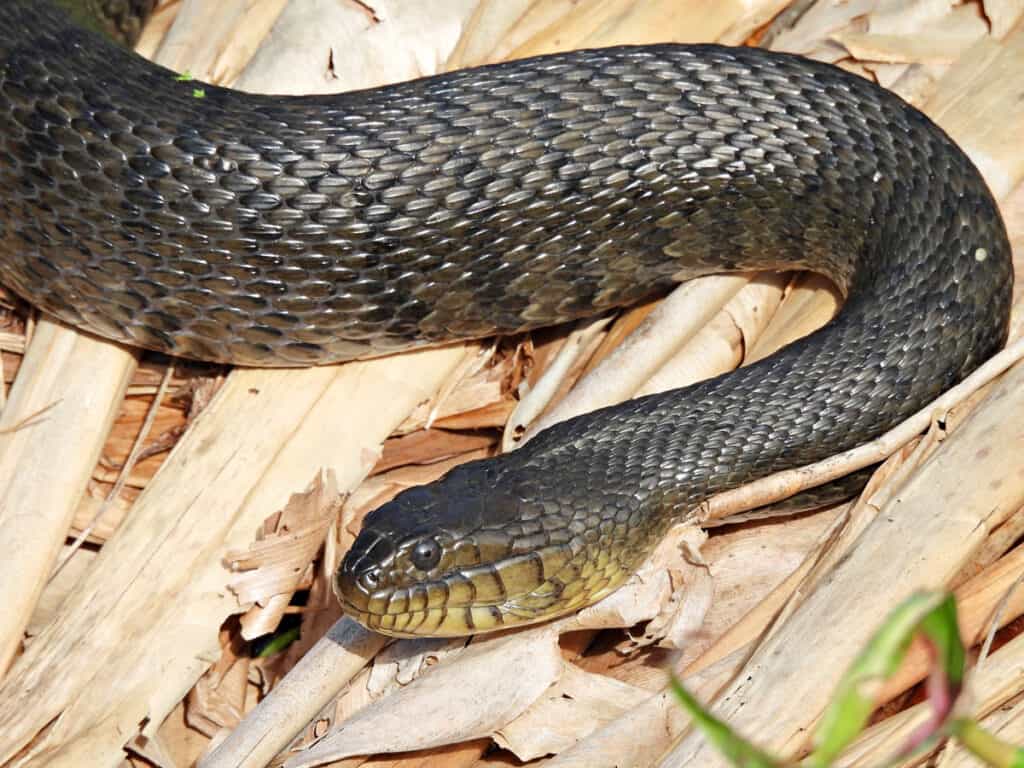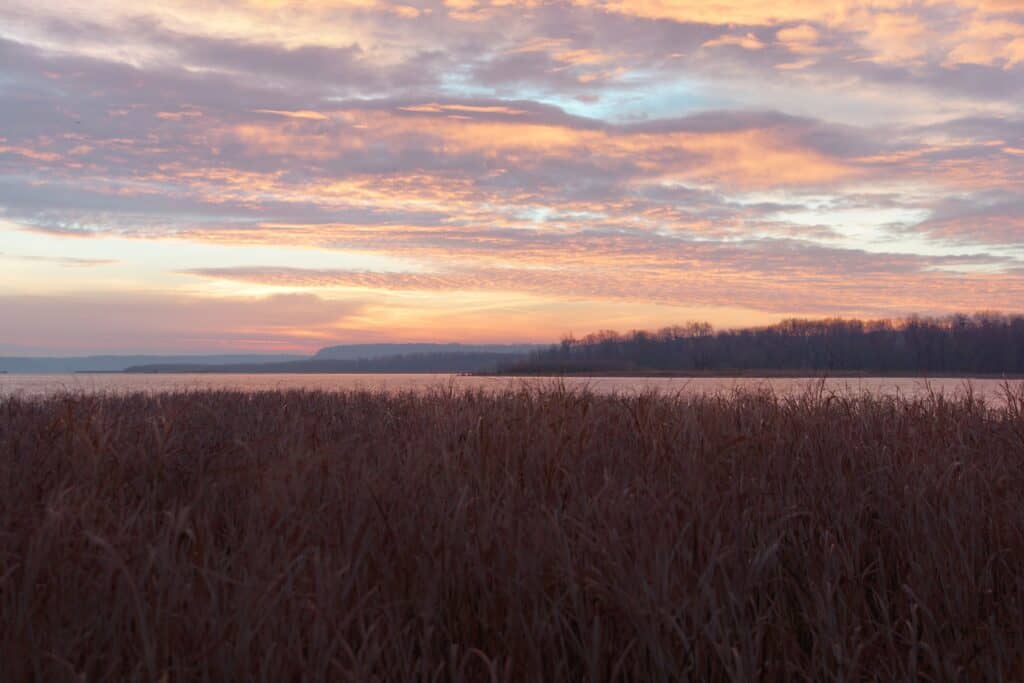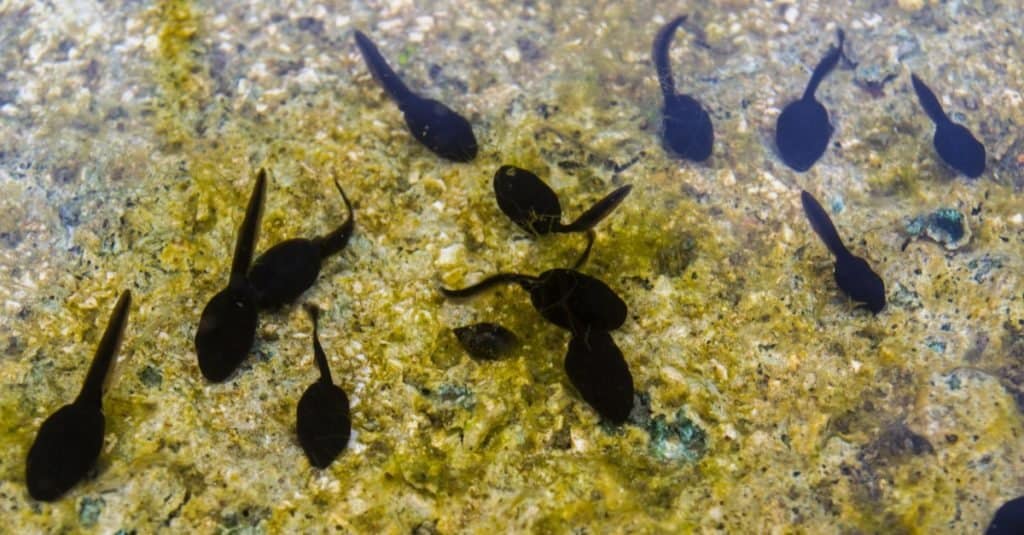As the weather grows warmer, you may notice more snakes emerging to bask in the sun. One of the snakes you might see is the green water snake. These snakes can be a common sight in certain regions. However, even though they’re common, they’re not an everyday sight. This can lead you to wonder where there live. And if you happen to come across one, you may also want to know if they are dangerous.
Below, you’ll find the answers to these questions and more. So, ready to learn more about the green water snake? Keep reading below!

The green water snake is a species of the least concern. It may also be known by the name “Mississippi green water snake.”
©Rusty Dodson/Shutterstock.com
About the Green Water Snake
The green water snake (Nerodia cyclopion) is a species of natricine snake. This means that they are 1 of 36 different species of snakes in the subfamily of Natricinae. Snakes in this subfamily are known for being relatively harmless to humans. While it isn’t true for all three dozen species, natricine snakes also tend to prefer water environments with a diet rich in aquatic animals.
There are no subspecies of the green water snake. However, this hasn’t always been true. Previously, the Florida green water snake (Nerodia floridana) was considered a subspecies. It’s listed as its own species, although it’s closely related.
This is a species of the least concern. It’s known by the name “Mississippi green water snake.”

Previously, the Florida green water snake was considered a subspecies of the green water snake. Now, it’s listed as its own species.
©iStock.com/passion4nature
Appearance
At a glance, it greatly resembles other species of water snakes in the United States. They have dense, heavy body that measures anywhere from 30 to 55 inches with their tails.
On its dorsal side or its back, they sport one of many colors. This includes dark green or olive, where its name comes from, and other colors like murky brown. The green water snake is much brighter on its ventral side or its belly. Its belly is typically yellow.
One of the best ways to tell this species from other species of water snakes in the United States is to take a look at their eyes. It has a series of several small scales around their eye, creating the appearance of a ring of scales. The only other species of water snake to have this feature is the Florida water snake.

The green water snake has a series of several small scales around their eye, creating the appearance of a ring of scales.
©Ryan M. Bolton/Shutterstock.com
Habitat
It is found only in the southeastern United States. Like many other types of snakes in the subfamily Natricinae, they favor semiaquatic lifestyles. This means you can find them in a variety of freshwater sources common to the southeastern region of the United States. This includes everything from swampy bayous to lakes and ponds to slow-moving rivers and streams.
Although less common, you can also find them in brackish water. Brackish water is neither freshwater nor saltwater. It has a higher salt content than fresh water but not nearly as much as the ocean. Typically, brackish water is made by mixing freshwater and saltwater, and it is common when geographic instances like a river meeting the ocean occur.
One of the main reasons this snake is also known as the Mississippi green water snake is because of its habitat. It is most commonly located in the lower Mississippi River basin.

You can find green water snakes in everything from swampy bayous to lakes and ponds to slow-moving rivers and streams.
©RLW Photography/Shutterstock.com
Diet
Because it lives in a semiaquatic area, its diet reflects this. They are a carnivorous species. This means that all the nutrients they need are found solely in the animal matter, such as eggs or the animals themselves.
Some of the animals found in its diet include:
- Frogs
- Toads
- Tadpoles
- Small fish
- Salamanders
- Crayfish.
These are only the most common meals, however. They may also eat eggs and small mammals like mice and shrews when available.

Tadpoles are part of the green water snake diet.
©filippo giuliani/Shutterstock.com
Are They Dangerous?
Now that you know more about them, including where they live and how to identify them, you may wonder if they’re dangerous. This is especially true if you find yourself often wandering through their territory.
It is a nonvenomous species of snake. However, this doesn’t mean they can’t still pose a threat to humans. Their fangs are small, and they’re unable to consume a human-like, much larger snake. Still, it is a bite from a wild animal. This means that various bacteria can affect the wound, and while the initial bite may not be life-threatening, it’s still important to seek care for the bite.
The photo featured at the top of this post is © Jason Patrick Ross/Shutterstock.com
Discover the "Monster" Snake 5X Bigger than an Anaconda
Every day A-Z Animals sends out some of the most incredible facts in the world from our free newsletter. Want to discover the 10 most beautiful snakes in the world, a "snake island" where you're never more than 3 feet from danger, or a "monster" snake 5X larger than an anaconda? Then sign up right now and you'll start receiving our daily newsletter absolutely free.
Thank you for reading! Have some feedback for us? Contact the AZ Animals editorial team.






